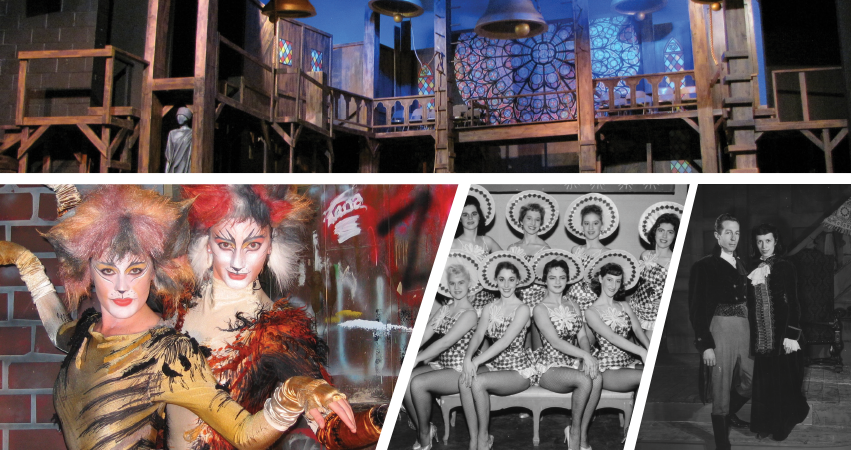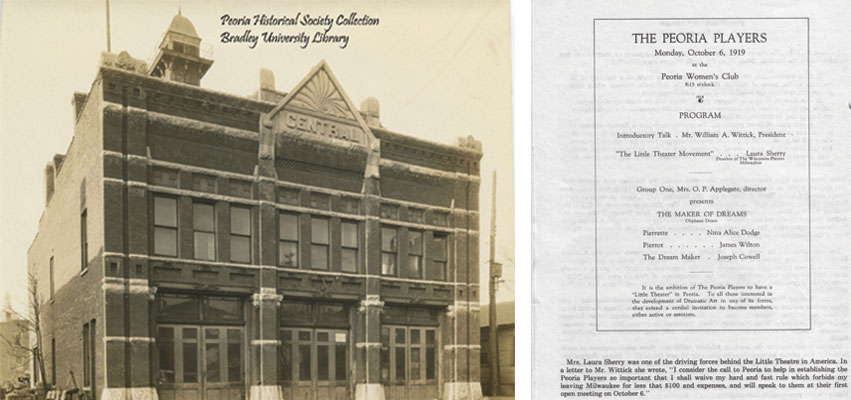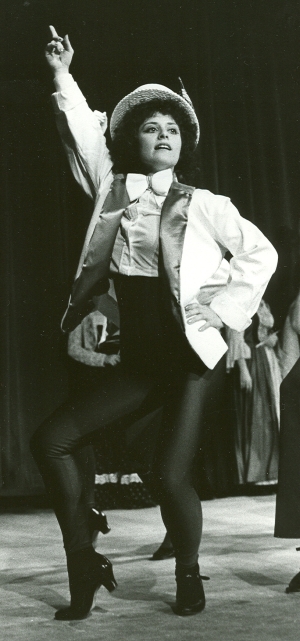
Peoria Players Theatre celebrates 100 years of sharing live theater with the community.
It's mid-morning on a hot, muggy day in August, and though there’s no show tonight, the lobby and auditorium of Peoria Players Theatre are bustling with cheerful commotion as volunteers work to complete renovations. “When we open our 100th season, our patrons will be treated to an updated lobby, new carpet and 302 brand-new theater seats,” manager Nicki Haschke says with excitement. In addition to the renovations and an outstanding season of shows, the Players have planned a full year of events and activities leading up to the centennial anniversary of its premiere performance in October 2019.
Peoria Players Theatre (PPT) was formed in 1919 (during the heyday of vaudeville and the emergence of American cinema) as part of the “Little Theatre Movement,” which sought to counter the melodramatic spectacles of the Victorian era with intimate, locally-based productions that explored realism and social issues of the day.  These “little theatres” evolved into the community theaters enjoyed by today’s audiences. When the founding Players debuted Oliphant Down’s The Maker of Dreams on October 6, 1919, they established a legacy involving generations of area residents, more than 800 plays, and a cultural impact on the community that’s impossible to quantify.
These “little theatres” evolved into the community theaters enjoyed by today’s audiences. When the founding Players debuted Oliphant Down’s The Maker of Dreams on October 6, 1919, they established a legacy involving generations of area residents, more than 800 plays, and a cultural impact on the community that’s impossible to quantify.
That first production took place on a small stage in the Peoria Women’s Club in downtown Peoria, and shows continued there until the group was able to repurpose the former Jackson Street firehouse into its own theater in 1933. When the construction of I-74 threatened to displace the troupe in the mid-‘50s, local architect Les Kenyon was commissioned to build a new auditorium at the corner of University and Lake—a home the Players have happily occupied since 1957. During periods of transition, determined members still performed as a traveling company, allowing PPT to maintain its status as the fourth-oldest continuously-running community theater in the nation.
Despite societal changes, challenging economies and technological innovations that provide instant, endless choices of entertainment, PPT continues to thrive due to the talent and dedication of its participants, the quality of its productions, and unwavering support from the community.

Above left: The Players remodeled the former Jackson Street firehouse into a theater in 1933.
Right: Original playbill from the Players' first show in 1919.
Something for Everyone
“Throughout our history, there have been so many people who have helped in numerous ways to preserve our longevity,” Haschke acknowledges. “We like to offer productions that will entertain our audience members, but also challenge our talent pool.” Striking this balance keeps patrons, performers and stage techs challenged and interested, while providing opportunities for everyone in the community to get involved, regardless of age or experience. Haschke notes that one of this season’s shows will feature a baby on stage, and recalls how Harold Ernst auditioned and performed for the very first time at the age of 80 for the 1994 production of Phantom of the Opera.
While the Players originally performed only dramas and comedies for the first few decades, Haschke says musicals (with live orchestration) became and remain the obvious crowd favorites. “Our 99th season-closing production, Mamma Mia!, broke box office records,” she explains. “We sold out our scheduled shows, added five holdovers and sold those out—before we even opened!”
Every season is carefully curated to be well-rounded with recognized standards, regional premieres and original works. Planning for the centennial season also involved reviving historically significant productions and incorporating input from patrons. In August, the Players’ Summer Youth Theatre kicked off the festivities with a reprisal of Grease—a nod to the first SYT production in 1997—while patrons voted for their favorite productions to bring back for this commemorative season, including A Chorus Line and Wizard of Oz. Rounding out the 2018-2019 roster are Steel Magnolias, the regional premiere of Elf the Musical, West Side Story and Dreamgirls, as well as special performances of The Rocky Horror Picture Show (an October tradition for 27 years), Christmas one-acts written by local playwrights, and the Sinatra revue, A Ring-A-Ding-Ding New Year.

The marquee at Peoria Players Theatre is the last of the "chasing lights marquees" in the city. The stone benches are plynths taken from PPT's former home at the old Jackson Street theatre.
The planning for these commemorative events began back in 2015. Spearheaded by PPT members Bruce and Pat White, nine committees of volunteers have developed an impressive variety of festivities designed to generate community excitement all year long. Starting over the summer, the “Century Sweep” selfie contest encouraged patrons to take selfies at local arts organizations and share on social media for the chance to win season tickets. Supporters also have the opportunity to purchase candles to light up the giant birthday cake in the theater lobby, which incorporates playbills from past shows.
 In order to properly document the theater's history, they compiled and published a book, Peoria Players Centennial History, and worked with WTVP to produce a documentary, which was screened at the opening reception of Peoria Players Theatre: 100 Years at the Peoria Riverfront Museum. The museum exhibit further tells the story of PPT’s role in Peoria history, including historical photographs, playbills and posters, costumed mannequins, rare props, and even a small stage for special performances and educational activities.
In order to properly document the theater's history, they compiled and published a book, Peoria Players Centennial History, and worked with WTVP to produce a documentary, which was screened at the opening reception of Peoria Players Theatre: 100 Years at the Peoria Riverfront Museum. The museum exhibit further tells the story of PPT’s role in Peoria history, including historical photographs, playbills and posters, costumed mannequins, rare props, and even a small stage for special performances and educational activities.
In addition, the Players will host a Gala Celebration fundraiser in January, a trip to Chicago to see the new Broadway hit Dear Evan Hansen in March, and a special Century Celebration Revue in June. This series of centennial celebrations will culminate with the official 100th Birthday Party on October 6, 2019, to precisely mark the milestone.
The hours upon hours of hard work required to make each event a success are a testament to the dedication of those involved. “By the time all of these initiatives come to pass, over 50 Players folks will be involved in the planning and execution of the theater's plans for the 100th... and hundreds more in the on-stage productions,” notes Bruce White.
Dramatic Inclinations
What drives members to contribute so much time and energy to the theater? Humans are inherently theatrical creatures—there’s nothing more dramatic or comedic than life itself. Since the beginning of civilization, live theater has captivated audiences with a certain kind of magic that’s impossible to produce through other forms of entertainment—an enchanting energy that becomes even more magnetic for those compelled or inspired to act, direct, make costumes, build sets, run sound and lights, or join the chorus.
The theater's inclusive, welcoming atmosphere is one element that brings people back, says Haschke. “It’s like a family, and everyone is always willing to pitch in and help wherever needed.” Her mother Sherry, for example, has been involved for 40 years as bookkeeper, box office assistant and historian; Haschke started acting at a young age and has now worked there for 26 years. “I really kind of grew up here—it’s like a second home.”
The Whites became involved in the 1970s and have filled a range of roles as actors, directors, board members and crew members. They agree the bonds that form during a production have a lasting impact. “Each show is memorable in some way... especially considering the many friendships formed with cast and crew members,” Bruce remarks. Pat has also served as costumes mistress and choreographer for shows. “I wanted to be a dancer—theater came after the fact,” she says. “But with musicals you can do both!”

The cast and crew of The Wizard of Oz, September 2018. Photo by Eric Haschke
Participants sometimes drive from as far away as Monmouth, Rockford or Danville during the intense weeks of rehearsals leading up to a show. Many participate in multiple shows each year, including productions with other theaters. PPT often collaborates with other performance organizations, such as the Central Illinois Ballet, and the fact that the theater community still supports multiple acting troupes and theaters speaks to the appetite and appreciation residents have for the performing arts.
While it can be difficult for some community theaters to contend with the big-budget productions of professional companies, the Players take pride in producing high-quality shows and nurturing top-notch talent. PPT was recently honored by the Illinois Theatre Association with the Community Theatre Award of Excellence, and its productions often win community votes for Peoria Magazines’ “Best of Peoria” or the Journal Star’s “Best of the Best” awards. Several members have even gone on to professional careers on Broadway or in Hollywood, including the Academy Award-winning makeup artist Tami Lane and performer Brian Andrews, who danced in Broadway productions of A Chorus Line and Cats.
 The Players understand that their continued success means attracting and fostering young talent. “There’s a core stable of actors who continuously do shows, but it’s always wonderful to see new faces,” Pat says. “The emerging success of youth theater has continued to produce talent looking for an opportunity to participate,” adds Bruce. “Players’ collaboration with Children's Community Theatre is evidence of that dynamic.”
The Players understand that their continued success means attracting and fostering young talent. “There’s a core stable of actors who continuously do shows, but it’s always wonderful to see new faces,” Pat says. “The emerging success of youth theater has continued to produce talent looking for an opportunity to participate,” adds Bruce. “Players’ collaboration with Children's Community Theatre is evidence of that dynamic.”
More Than an Encore
The beauty of community theater is how literally it requires the involvement and investment of the local community (while serving as a supportive, familial structure within itself)—these aren’t just paid professionals touring from city to city. A truly symbiotic relationship exists between members and supporters: members work hard to create an experience that is entertaining, emotional and enlightening, while the consistent patronage of audiences and donors makes it possible to continue. Not everyone wants to become a star on the stage, but spouses who run lines with their partners, coworkers who come to opening nights, or season ticketholders who faithfully attend every show play essential roles.
“Community theaters are vital to the arts culture in any locale,” notes Bruce. They portray the highs and lows of the human experience, expose people to different perspectives and explore challenging issues, while providing participants an outlet for artistic expression and skills development. Peoria Players Theatre has been such a foundational contributor to Peoria’s culture and commitment to the arts, it’s hard to imagine the community without it. A century of success indicates more likely than not, the Players will reprise its lead role as Peoria’s “Maker of Dreams” for another hundred years. a&s
Visit peoriaplayers.org or call (309) 688-4473 for a full schedule of shows, centennial events, auditions, tickets or ways to get involved.
- Log in to post comments

